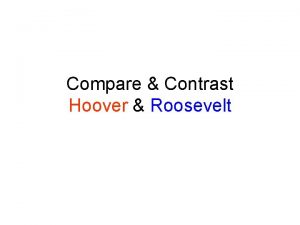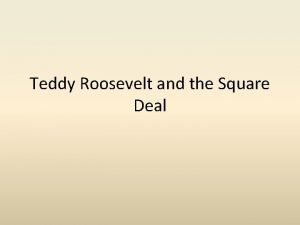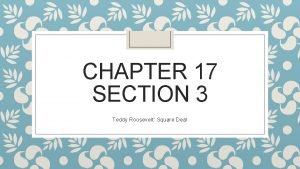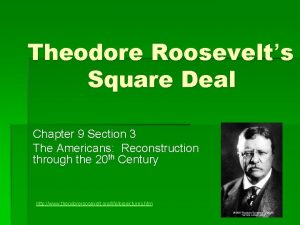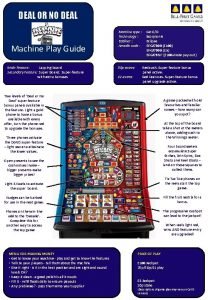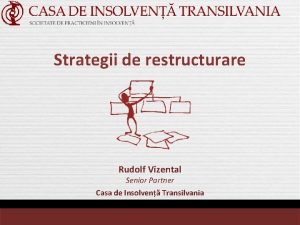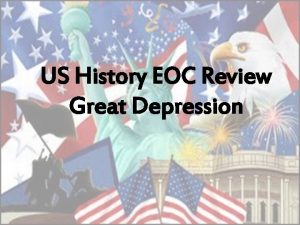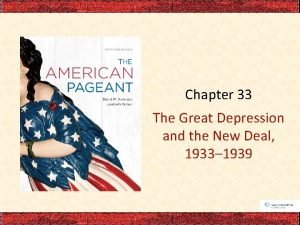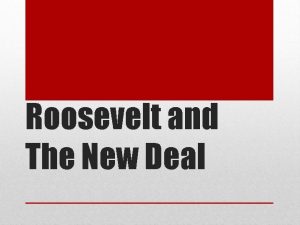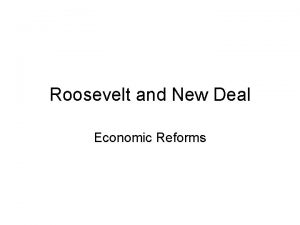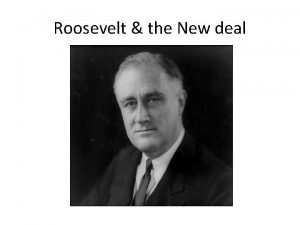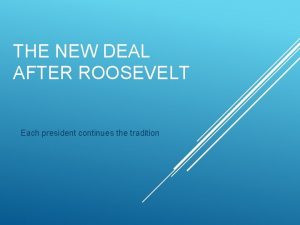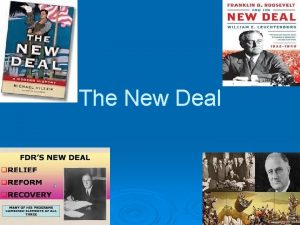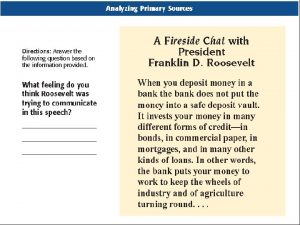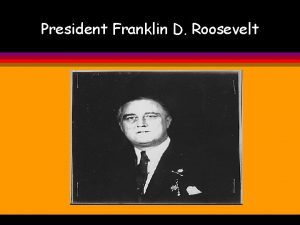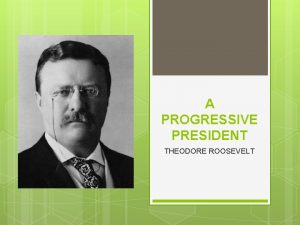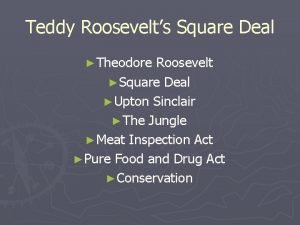PRESIDENT ROOSEVELT AND THE NEW DEAL The New














- Slides: 14

PRESIDENT ROOSEVELT AND THE NEW DEAL

The New Deal O The New Deal was the name of President Franklin Roosevelt's agenda for rescuing the United States from the Great Depression. O Roosevelt’s plan called for: O Relief O Recovery O Reform

Bank Holiday O On March 6, 1933, two days after becoming president, Roosevelt declared a five-day national bank holiday to close banks temporarily. O FDR hoped that a short break would give the surviving banks time to reopen on more solid footing.

Fireside Chats O From March 1933 to June 1944, Roosevelt addressed the American people in some 30 speeches broadcast by radio. O Roosevelt spoke on a variety of topics from banking to unemployment, millions of people found comfort and renewed confidence in these speeches which became known as the “fireside chats. ”

Alphabet Soup Agencies O Between 1933 and 1939 dozens of federal programs, often referred to as the Alphabet Agencies, were created as part of the New Deal. O With FDR's focus on "relief, recovery and reform, “ the legacy of the New Deal is with us to this day.

PWA (PUBLIC WORKS ADMINISTRATION) O The PWA was intended for industrial recovery and unemployment relief. O Eventually over $4 billion was spent on 34, 000 construction projects including public buildings, highways, bridges (e. g. , San Francisco's Golden Gate Bridge), and dams for water and power.

CCC (CIVILIAN CONSERVATION CORPS) O The CCC hired unemployed young men to work on flood control and reforestation projects, improve national parks, and build public roads. O For a wage of thirty dollars a month, approximately 3 million men worked in CCC camps during the program’s nine-year existence.

TVA (TENNESSEE VALLEY AUTHORITY) O The goal of the TVA was to modernize and reduce unemployment in the Tennessee River valley, one of the poorest and hardest-hit regions in the country. O The agency hired local workers to construct a series of dams and hydroelectric power plants, which brought cheap electricity to thousands of people.

AAA (AGRICULTURAL ADJUSTMENT ACT) O The AAA paid farmers to not plant crops in order to reduce surpluses, increase demand, and raise prices. O Farm income rose, but many tenant farmers and share-croppers were pushed into the ranks of the unemployed.

NRA (NATIONAL RECOVERY ADMINISTRATION) O The NRA was created to promote economic recovery by restoring competition. The NRA set business codes and quotas. O The NRA temporarily restored investor confidence and consumer morale, but it failed to stimulate industrial production.

WPA (Works Progress Administration) O The WPA employed more than 8 million people to build roads and highways, bridges, schools, airports, parks, & other public projects. O Under the arts program, many artists, photographers, writers became government employees, working on a myriad of public projects ranging from painting murals to writing national park guidebooks.

SSA (Social Security Administration) O Established in August 1935 under the Social Security Act, the SSA created a national pension fund for retired persons, an unemployment insurance system, and a public assistance program. O Today, it is the nation's most important and expensive domestic program, covering nearly 49 million Americans and accounting for about ¼ of the federal budget.

Effects of the New Deal O The New Deal policies did much to get Americans back on their feet, but its policies and programs did not end the Depression. O While its programs provided relief, recovery, and reform---The New Deal is remembered for drastically changing, and increasing the federal government’s role in politics and society.

Fireside Chat http: //millercenter. org/president/fdroosev elt/speeches/speech-3306
 Compare and contrast herbert hoover and fdr
Compare and contrast herbert hoover and fdr Teddy roosevelt and the square deal
Teddy roosevelt and the square deal Chapter 17 section 3 teddy roosevelt's square deal
Chapter 17 section 3 teddy roosevelt's square deal Chapter 9 section 3 teddy roosevelts square deal
Chapter 9 section 3 teddy roosevelts square deal Teddy roosevelt's square deal worksheet
Teddy roosevelt's square deal worksheet Deal or no deal machine
Deal or no deal machine Rudolf vizental
Rudolf vizental President vice president treasurer secretary
President vice president treasurer secretary Aaa new deal logo
Aaa new deal logo Dust bowl migration map
Dust bowl migration map Main idea
Main idea Chapter 33 the great depression and the new deal
Chapter 33 the great depression and the new deal New deal alphabet soup
New deal alphabet soup The new deal affects many groups
The new deal affects many groups Apush new deal
Apush new deal
